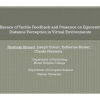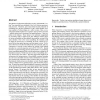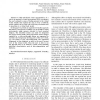439 search results - page 4 / 88 » Measuring presence in virtual environments |
VR
2010
IEEE
2010
IEEE
Influence of tactile feedback and presence on egocentric distance perception in virtual environments
13 years 4 months ago
MTA
2008
2008
Virtual interpersonal touch: Haptic interaction and copresence in collaborative virtual environments
13 years 6 months ago
As digital communication becomes more commonplace and sensory rich, understanding the manner in which people interact with one another is crucial. In the current study, we examined...
APGV
2005
ACM
13 years 11 months ago
2005
ACM
The illusion of self-motion induced by moving visual stimuli (“vection”) has typically been attributed to low-level, bottom-up perceptual processes. Therefore, past research h...
PRESENCE
2010
13 years 27 days ago
2010
Few HMD-based virtual environment systems display a rendering of the user's own body. Subjectively, this often leads to a sense of disembodiment in the virtual world. We expl...
VW
2009
Springer
14 years 22 days ago
2009
Springer
—A fully-articulated visual representation of a user in an immersive virtual environment (IVE) can enhance the user’s subjective sense of feeling present in the virtual world. ...



